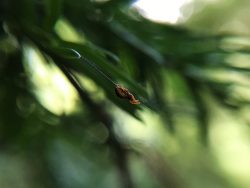Rare spider discovered at Kingley Vale
August 25, 2017
Written by Matt Dowse, SDNPA Ranger | Photo © Hugh Lansdown
Some species don’t need much conservation advocacy work. The number of members that organisations such as the RSPB and even the Bumblebee Conservation Trust can boast, as well as the number of participants in citizen science projects such as the Big Butterfly Count attest to our enthusiasm for the brightly coloured, feathered or furry. Other species, however, aren’t quite so revered by the public, and an unfortunate consequence is that they are often under-recorded in our countryside.
Such is the case for spiders in the UK, where disinterest can extend into phobia. Which is a shame, because spiders come in a fascinating array of sizes and colours, with equally fascinating life histories. Some of my favourites include the ant-mimicking Myrmarachne formicaria; any of the jumping spiders – which have some of the best vision of any arthropod – though particularly males Euophrys frontalis; the luminous green huntsman Micrommata virescens, or perhaps best of all, the enigmatic lady bird spider Eresus cinnabernius. Just search on Google for any of those, and look at the images to see what I mean!
A few years back I was fortunate enough to find a rare heathland species with the almost unpronounceable name Uloborus walckenaerius. It spins a very distinctive horizontal orb web (the kind of design a child would come up with if you asked them to draw a spider web), and sits beneath it waiting for prey. Reading about it in spider ID books, I happened to read also about the only other species in the same family in the UK, Hyptiotes paradoxus. Thankfully this species has been afforded a common name – the triangle web spider – because of the unique triagle-shaped web it spins, which is unmistakable in the field.
Identifying spiders to species level can be a fiddly and somewhat gruesome affair, often requiring killing them in order to stare at their genitals under a microscope. For those unfamiliar with the intricacies of species ID or biological field work, I promise you that I’m not joking. Enthusiastic though I might be, even I’m not that keen on identifying spiders, and tend to stick to those you can safely ID in the field, without all the arachnocide and intrusion. Anything that has a ‘distinctive’ web is therefore instantly interesting.
 Further reading revealed that the triangle web spider is listed as rare in the UK, appearing in the UK Red Data Book for spiders. It is found on evergreen trees and bushes, particularly yew and box, and is confined to habitats in southern England that have large numbers of these trees. I was therefore surprised to learn that there were no records for the species at Kingley Vale. Surely if a species is associated with yew trees, you’d find it in the largest yew woodland in Britain? This started a hunch with me that in fact the triangle web spider was at Kingley Vale, but simply hadn’t been recorded there.
Further reading revealed that the triangle web spider is listed as rare in the UK, appearing in the UK Red Data Book for spiders. It is found on evergreen trees and bushes, particularly yew and box, and is confined to habitats in southern England that have large numbers of these trees. I was therefore surprised to learn that there were no records for the species at Kingley Vale. Surely if a species is associated with yew trees, you’d find it in the largest yew woodland in Britain? This started a hunch with me that in fact the triangle web spider was at Kingley Vale, but simply hadn’t been recorded there.
This hunch was reignited with my recent move to the Central Downs team, particularly as I am fortunate enough to have Kingley Vale in my new patch. Finally deciding to bare it out, I visited the site with a friend last weekend to search for the triangle web spider. It wasn’t particularly easy going, after all Kingley Vale is very large and the spider – if it was there at all – is very very small. But, after two hours of fruitless wandering we were rewarded by finding four individuals (three sub-adult and one adult female). Their webs are certainly as distinctive as the ID books suggest, and are by far the easiest way of finding the spiders, which only reach 5mm when fully grown. Unfortunately spider silk isn’t always easy to see in the sunlight. I’m convinced there are more there than the four individuals we found, so am planning to return one evening after dark to search with torches, which show up the webs far better.
In the meantime, the records of the four we found have been submitted to the Sussex county recorder for the British Arachnological Society’s Spider Recording Scheme. I’m currently waiting to hear back as to whether it is a new county record for West Sussex. Even if not, they are certainly a new species record for Kingley Vale, adding to the wealth of existing biological interest at the site.
